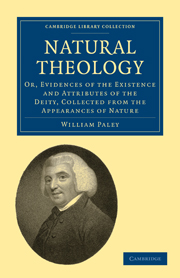 Natural Theology
Natural Theology Published online by Cambridge University Press: 07 September 2010
Whenever we find a general plan purfues, yet with fuch variations in it, as are, in each cafe, required by the particular exigency of the fubject to which it is applied, we poffefs, in fuch plan and fuch adaptation, the ftrongeft evidence, that can be afforded, of intelligence and defign; and evidence, which the moft completely excludes every other hypothefis. If the general plan proceeded from any fixed neceffity in the nature of things, how could it accommodate itfelf to the various wants and ufes which it had to ferve, under different circumftances, and on different occafions? Arkwright's mill was invented for the fpinning of cotton. We fee it employed for the fpinning of wool, flax, and hemp, with fuch modifications of the original principle, fuch variety in the fame plan, as the texture of thofe different materials rendered neceffary. Of the machine's being put together with defign, if it were poffible to doubt, whilft we faw it only under one mode, and in one form; when we came to obferve it in its different applications, with fuch changes of ftructure, fuch additions, and fupplements, as the fpecial and particular ufe in each cafe demanded, we could not refufe any longer our affent to the propofition, “that intelligence, properly and ftrictly fo called, (including under that name, forefight, confideration, reference to utility,) had been employed, as well in the primitive plan, as in the feveral changes and accommodations which it is made to undergo.”
To save this book to your Kindle, first ensure [email protected] is added to your Approved Personal Document E-mail List under your Personal Document Settings on the Manage Your Content and Devices page of your Amazon account. Then enter the ‘name’ part of your Kindle email address below. Find out more about saving to your Kindle.
Note you can select to save to either the @free.kindle.com or @kindle.com variations. ‘@free.kindle.com’ emails are free but can only be saved to your device when it is connected to wi-fi. ‘@kindle.com’ emails can be delivered even when you are not connected to wi-fi, but note that service fees apply.
Find out more about the Kindle Personal Document Service.
To save content items to your account, please confirm that you agree to abide by our usage policies. If this is the first time you use this feature, you will be asked to authorise Cambridge Core to connect with your account. Find out more about saving content to Dropbox.
To save content items to your account, please confirm that you agree to abide by our usage policies. If this is the first time you use this feature, you will be asked to authorise Cambridge Core to connect with your account. Find out more about saving content to Google Drive.